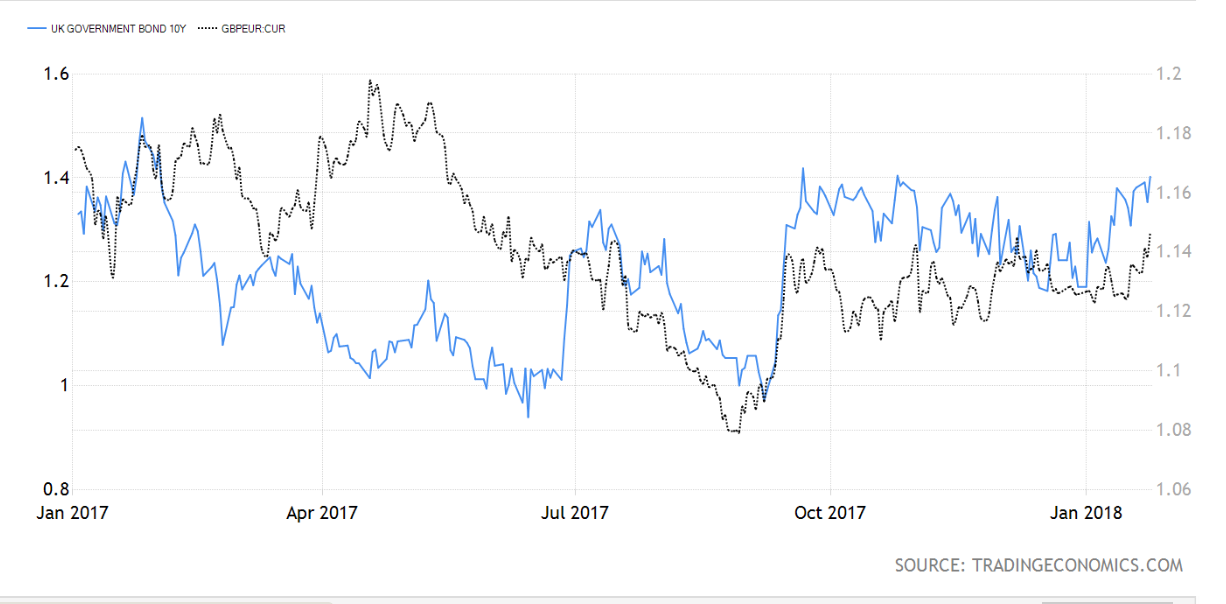Sterling and the End of ECB Quantitative Easing - What will Happen?

Data suggests European monetary stimulus has been helping to finance the UK and when it is switched off UK debt markets may suffer but the Pound may rise...
As the European Central Bank (ECB) weans the Eurozone off quantitative easing the Euro is expected to strengthen, however, research from US broker-dealer Jefferies International, suggests the end of QE could also be positive for the Pound, and gains for the Euro over Sterling may be limited.
The call comes on the eve of the January policy meeting of the ECB where most analysts expect policy-makers to maintain the message that the end of monetary stimulus is due in coming months.
QE - at its most basic is the printing of money to buy assets such as government and corporate bonds - is an elaborate form of emergency stimulus which has helped boost the Eurozone economy.
The process involves the central bank buying government bonds from Eurozone financial institutions which they then lend on to businesses and invest where appropriate. The programme has left Eurozone banks with a glut of cash which they have also invested externally - predominantly in UK government bonds (gilts) and US Treasury bonds.
Therefore a good chunk of the money printed by the ECB is being recycled out of the Eurozone. This helps explain why the Euro suffered on the commencement and duration of QE while the Dollar and Pound benefited.
"The circle continues to be squared in part by the ECB and its QE policy recycling the euro area’s current account surplus into fixed markets globally. The third quarter of last year saw, in particular, strong buying of US fixed income (€240.5bn at an annualized rate), and on-going financing of the UK current account deficit (4.5% of UK GDP inQ3 2017) through the Gilt market," says David Owen, Managing Director of Jefferies International.
Since the amount of interest paid to a bondholder is set at issuance the yield reflects the interest - or coupon as it is known technically - as a percentage of the bond's fluctuating price; when the price falls the yield rises as the interest is relatively greater compared to the market price of the bond.
When this tap of funds is 'switched off' by the ECB (expected late 2018/2019) this demand for UK gilts will fall away, probably resulting in a fall in demand for UK Gilt's which are likely to fall in price.
This seems to suggest that if Eurozone demand for Gilts falls, as the Jefferies' analysis suggests, and bond prices fall, yields on Gilts will rise, and rising yields are usually positive for Sterling, so the Pound could rise too.
The chart below shows the relatively close correlation between 10-year Gilt yields and GBP/EUR, which has been especially close recently:

(Image courtesy of tradingeconomics.com)
Higher yields normally reflect a more inflationary environment in which bonds lose favour, however, higher inflation is normally positive for currencies because it means higher interest rates, and these attract greater inflows of foreign capital seeking higher returns.
It's all down to Brexit
The correlation between Sterling and Gilt yields is normally closest when there are no major risk factors present, such as the uncertainty associated with Brexit, according to leading bank analysts.
"The speculation about Hard Brexit has brought not just a change in investors’ confidence but a break in the correlation between the pound and UK assets, argues Jordan Rochester, FX strategist at Nomura, quoted in an article on the FT.com.
"The typical reserve currency relationship with higher yields that would see sterling higher on a gilt sell-off, has been broken,” continues the analysts in an article in October 2017.
This suggests that a major condition for the Pound rising after QE is the level of ongoing Brexit uncertainty.
Heightened Brexit uncertainty appears to lower investor inflows despite rising interest rates, probably because they pose such a volatile currency risk that the gains from higher yields are offset by the risk of significant currency weakness.
One major concern for Sterling is that Brexit talks will break down and this could raise considerable financial market risks beyond the more prosaic economic risks from the imposition of trade tariffs.
The UK continues to import more than it exports and to finance this imbalance needs to borrow - in the form of selling Gilts, for example.
If the market for Gilts falls after QE and the correlation with Sterling breaks down the UK may struggle to borrow enough to pay down its current account deficit.
"In terms of financing the UK’s very large current account deficit since the UK’s 2016 EU referendum, this has been a very fortuitous development. Going forwards, with the ECB set to potentially stop QE this September it is important that the UK current account deficit is seen to close significantly," says Jefferies' Owen.
Get up to 5% more foreign exchange by using a specialist provider to get closer to the real market rate and avoid the gaping spreads charged by your bank when providing currency. Learn more here.









